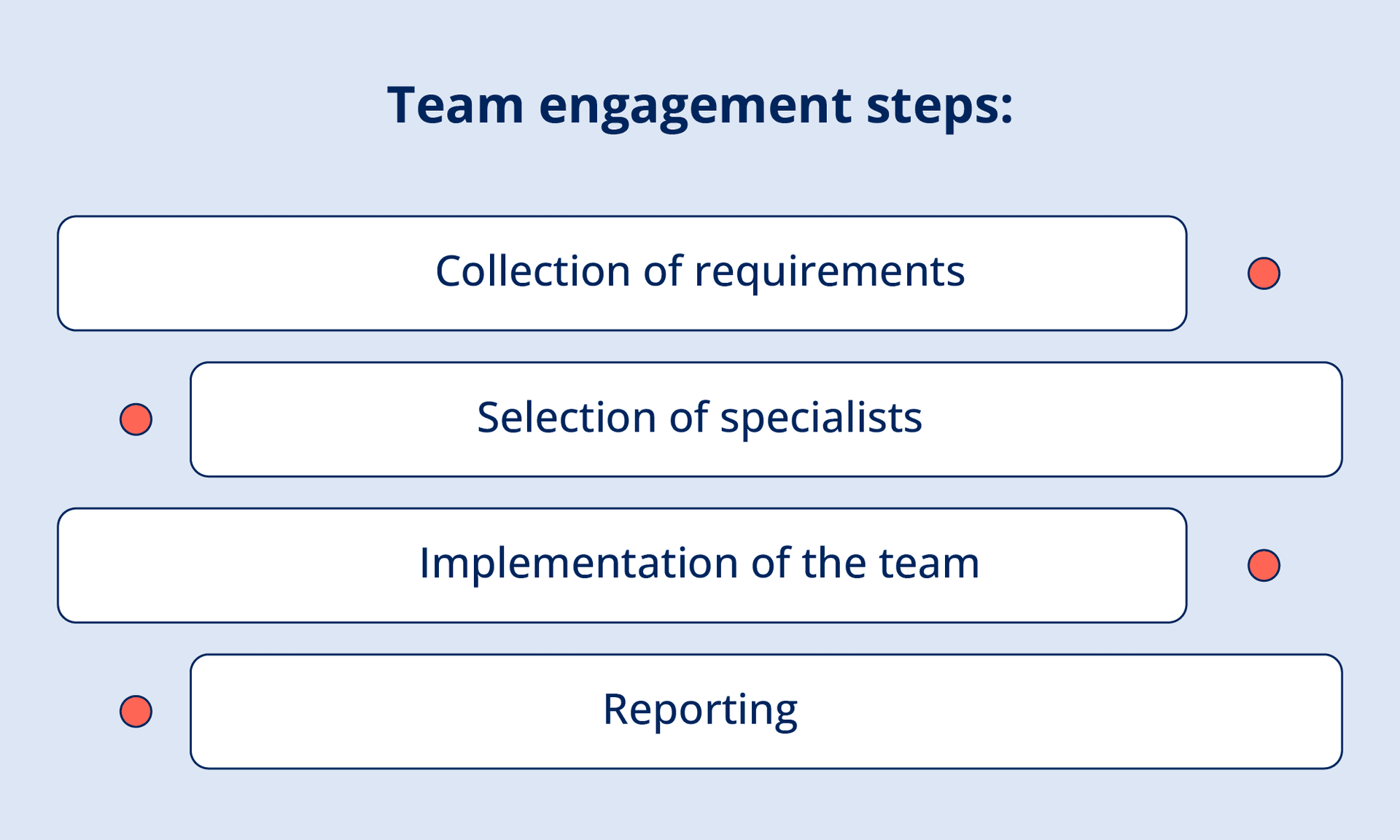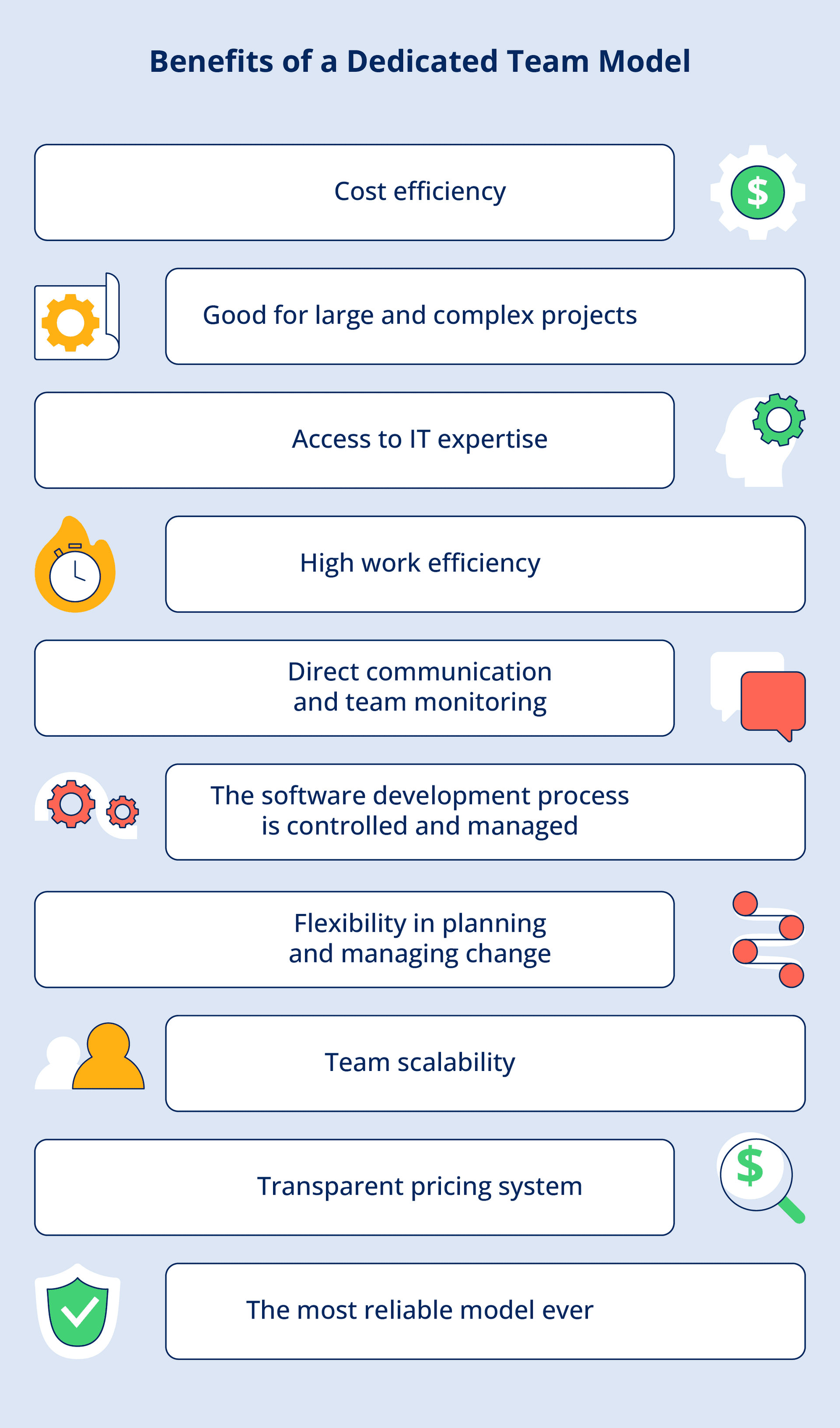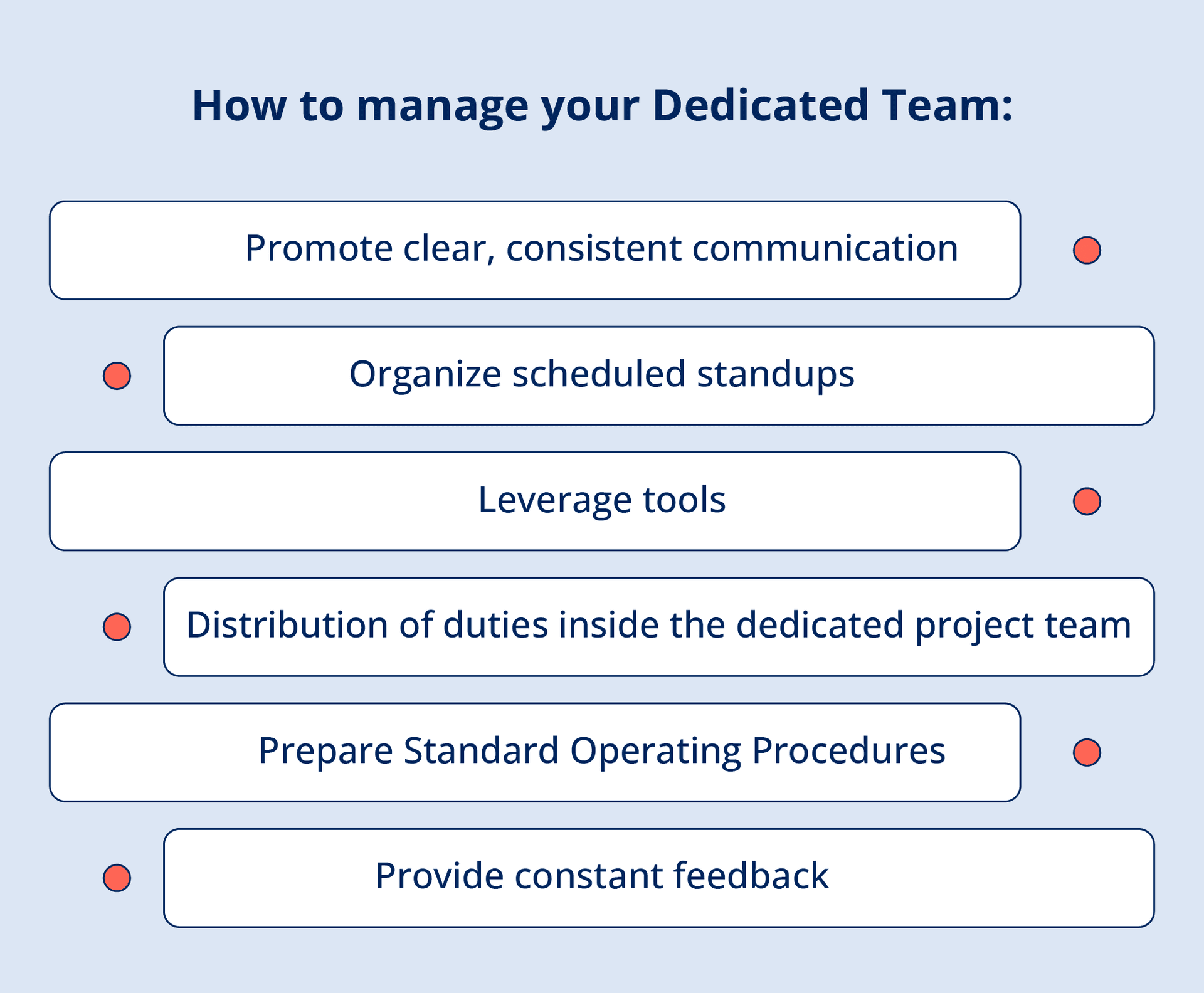The success of any business project is inextricably linked with the work of the technical team. Depending on the scale of the project, its goals, and features, as well as financial capabilities, the company chooses the most convenient model of interaction with the IT contractor. Recently, companies are increasingly resorting to the introduction of a unique group of developers into their structures through outsourcing.
There are many models of interaction, among which we can distinguish: fixed cost, time and materials, fixed time and budget… But among all, the innovative Dedicated Team model differs significantly.
It is important for project managers to carefully consider the specific needs and goals of their project before deciding whether or not to use the dedicated team model. They should also ensure that the team is composed of skilled and experienced professionals who are fully committed to the project and have a good understanding of the client's expectations.
Moreover, it's crucial to establish clear communication channels, define roles and responsibilities, and monitor progress and performance throughout the project. By doing so, project managers can maximize the benefits of the dedicated team model while minimizing the potential drawbacks, and ensure a successful outcome for their project.
A dedicated team is formed based on the customer's goals, wishes, and requirements. This model is great for developing large, long-term projects where requirements change frequently. It is quite flexible regarding the scope of work and tasks, costs and resources, as well as regarding the development team itself.
By hiring a dedicated team, you are, in a sense, hiring a coherent organism that is inspired by your goals, follows your direction, and won't leave you halfway to your goal if something goes wrong.
There are two aspects to forming a dedicated team. In the first case, the team is a separate full-service group, which includes all the necessary employees, such as the project manager, designer, etc. In another case, the customer may hire a dedicated team to expand his own, this strengthens his team with several external experts.
What Is a Dedicated Team Model?
The Dedicated Team Model is a model of cooperation with a digital service provider in which the client is provided with software development specialists on a long-term basis. A team of specialists is selected in accordance with the requirements of the project, based on their experience and skills. Development management and communication process coordination may remain the responsibility of the implementer. The team usually works from the service provider's office in this case.
The main goal of this model is to quickly hire a team that will fill the gap in the necessary knowledge and work like your own. This interaction format allows either to completely replace the development staff or to establish joint work with the internal team, subject to a clear division of responsibility.
Team engagement steps:
-
Collection of requirements: the contractor studies the requirements of the project, and wishes for the organization of the workflow;
-
Selection of specialists: based on the requirements, experienced specialists who own the necessary technologies are selected. This process can take several weeks;
-
Implementation of the team: at this stage, responsible persons, preferred communication channels and management tools are fixed. In some cases, the team leader first gets acquainted with the project, to which additional team members gradually join;
-
Reporting: according to a pre-agreed format, the client is provided with reports on the hours spent on development. Based on these hours, the services are billed monthly.

Benefits of a Dedicated Team Model
1. Cost efficiency
Customers save a lot on infrastructure because, by hiring a team, they get paid hourly for remote work on a project. There are no worries such as renting an office, purchasing equipment, paying electricity bills, etc. Moreover, it is much cheaper to hire an already well-coordinated team than to independently look for developers with the necessary skills.
2. Good for large and complex projects
This model is useful for projects where it is difficult to think through everything to the end when it is important to be patient and disciplined. It is quite flexible and can adapt to any changes.
3. Access to IT expertise
When you hire an organized, responsible development team, it allows you to compensate for the lack of specialists for the implementation of your unique business idea. At the same time, you get the experience of experts, the necessary skills, knowledge, and resource base.
4. High work efficiency
The execution team profoundly understands the requirements of the project, is quality-oriented, and works on a long-term basis.
5. Direct communication and team monitoring
According to this model, the client can directly manage each specialist provided by the IT company.
6. The software development process is controlled and managed
The customer participates in the process of hiring IT specialists, and also manages the development process at all stages, receiving regular reports on completed tasks. If desired, they can outsource all work on the project to an outsourcing company that provided a dedicated team.
7. Flexibility in planning and managing change
The customer at any stage can make changes to the project, adding functions to the software product, as well as distributing tasks among performers.
8. Team scalability
From the very beginning, the customer independently decides how many people need to be hired for software development. If necessary, customers can add members, as well as reduce or increase the team.
9. Transparent pricing system
The total cost of the project is formed from the tasks set and the time required to complete them. Every month, the client pays the salary of all team members, as well as the service provider.
10. The most reliable model ever
This is achieved through the flexibility of the model, transparency, and 100% payback of the hired team. It allows you to avoid many risks, including overpayments in the process of creating a product.

When the Dedicated Team Works and When Doesn’t
When it Works
The format is well suited in cases where you have development experience, understand the life cycle of creating digital products, and know how to build processes for efficient work, but at the same time, you don’t have your own resources to implement the project.
Perhaps you do not have your own IT department, or it is too busy to be distracted from the strategic priorities of the business. For example, a full-time team is responsible for the back-end, and you urgently need front-end specialists to implement the redesign. If, at the same time, it is impossible to clearly define the scope of work, and the requirements change in the process, then it is beneficial to attract a dedicated team.
When It Doesn’t Work
Despite all the advantages of a dedicated team, it is necessary to know when it doesn't work.
This model is not for short-term projects. Dedicated teams are for long-term, flexible projects, so it is unhelpful both in terms of expenses and human resource use.
As teams are created for long-term collaboration, it requires signing a contract. So your project needs must be determined.
And, there are also the challenges of working in different time zones. Working with developers abroad has disadvantages, the time difference. It may affect problem-solving and communication, but with the right agile approach, it can be avoided.
Dedicated Development Team vs Fixed Price Model
1. Fixed price model
When to use:
-
When the project is short term.
-
When you have a complete description of the project, with clear goals, workflows, and deliverables.
-
When the likelihood that the requirements for the project will change is negligible.
-
When you work with a new contractor (a pilot project with a fixed estimate can be a great test of a contractor who promises to be your long-term partner).
-
The flat-rate model loves well-written and thorough documentation. Documentation, the requirements of which will not change. Of course, you can negotiate with the contractor about anything, but if the project is in full swing, and you decide to turn everything upside down, blame yourself. And keep in mind that the deadline (with a high probability) will be overdue, and the release of the project will be delayed.
In force majeure situations, the customer and you determine how important the changes are for the current version of the product. If you still need to change the composition of the tasks, but there is no way to push back the deadline, the only option left is to sacrifice other tasks.
2. Dedicated team model.
When to use:
-
In long-term software development, when the current development plan involves attracting additional resources and using new technologies.
-
When the initial needs and goals are not clear, that is, at the very beginning, it is not entirely clear what the end result will be (for example, in the case of a startup).
-
When you know in advance that project requirements or task priorities will change (since you have a dedicated team working for you, changing course is not difficult).
There are a number of details that need to be discussed in order to choose the model that is truly appropriate for you in each particular case. And discuss it directly with the contractor.
Dedicated Development Team vs Time & Material Model
Time & Material (TM) is an hourly rate of work. This model is suitable for customers who understand that the same project can be implemented in different ways. With TM, the client sets a task, and the performer estimates how long it will take and names the cost.
As development progresses, the project manager makes sure that the team stays on schedule and, if something does not go according to plan, warns the client and suggests options for solving the problem.
Working in the TM format helps to avoid misunderstandings, the client and the development team interact regularly and set goals more accurately. Risk management is shared between the client and the customer. It is clear to the customer where the money goes, he can control the process, refusing unnecessary functionality. If the customer changes the requirements, he will immediately see how this will affect the timing and cost.
Both customers and performers like the Dedicated team format. The customer receives the necessary specialists, monitors the quality of work, and can add an unlimited number of tasks. For the contractor, the Dedicated team format is good because the developers are provided with the necessary workload, and the customer is in charge of the project.
That is why the cost of this format of cooperation is cheaper than TM and Fixed Price.

Where to Find and Hire a Dedicated Team
-
Do detailed research
You have to do market research, which is one of the main phases of finding a trustworthy software company. Another important step to consider is the company's growth. Good companies tend to scale their business. You can find out in which countries they are located, and how many employees, this information is available on specialized sites for finding IT partners.
-
Ask industry experts
On such websites as Clutch, Good Firms, and IT Firms, you can find reviews that you need to study carefully. You will see how cooperation between IT vendor and clients went.
-
Verify their experience
Portfolio research is very important, you will understand the company's expertise to complete your task. You also can look through released projects.
-
Check their price and adherence to budget
You need to know if the company’s price accord with your budget, so you have to conduct an interview. Look for motivated people or a methodical team.
How to manage your Dedicated Team
-
Promote clear, consistent communication
-
Organize scheduled standups
-
Leverage tools
-
Distribution of duties inside the dedicated project team
-
Prepare Standard Operating Procedures
-
Provide constant feedback

It's impossible to be loyal to something you don't understand. Not clear tasks may confuse a dedicated team but all projects can be at risk. You must communicate your expectations to be clear to the dedicated team:
Write down the documentation, so you can review it later. It can consist of timelines of deliverables, solutions on how to best release a feature, and reports on daily progress.
Communication is a must. Organize scheduled standups with the dedicated development team to go over your expectations. Then talk to each team member, so to see the distribution of duties inside the dedicated project team
You need to be detailed in your feedback. In case, you want a developer to rewrite code, you have to find the time to explain why his code did not live up to the standards you expect, in conversation listen to his opinion. It will show company culture and will build trust with a dedicated development team.
Dedicated Teams FAQ
How can you be sure a dedicated development team model is right for the project?
A dedicated team is best suited for companies that need to expand expertise, are team-oriented, businesses with tight deadlines, and those that need managed offshore IT professionals. You don't spend time on development management but focus on the high-level tasks of your product and business. A dedicated team is committed to one and to one client at a time.
Your in-house team can focus on the development of the core product, without delaying the development of related projects.
The workflow is completely transparent, you control the result in real-time in the project management system and, thanks to detailed reporting, easily correlate it with costs.
The team is involved in your processes, infrastructure, and culture, you do not have to adapt or change the existing process.
Who needs a dedicated team?
DTM is a resourceful model of interaction within the framework of a software development service when the client receives at his disposal a team- of IT specialists, selected taking into account the requirements and specifics of the project. Partnership with a dedicated team is one of the most effective tools for optimizing a company's business processes. With the right building of partnerships, a dedicated team can become not just “insurance” or “spare hands” for the implementation of current tasks, but a strategic asset for productive business development. Many companies even manage to maintain a leading position in their segment precisely due to the competent distribution of operational tasks.
What is the difference between staff augmentation and DTM?
Staff augmentation is a type of outsourcing of software development services in which a software company provides its specialists in the form of external hire, usually on the basis of a contract of time and materials.
The dedicated team model is a type of outsourcing where you hire an entire remote extended development team and outsource the project to them. The outsourcing company you choose has a dedicated team, but it also includes a project manager, which reduces the need for hands-on management by the client.
This model involves a much broader partnership than simply staff augmentation as it also covers a wide range of software-related services such as business analysis, design, UI/UX design, quality assurance, project management, support and maintenance.
How can I verify the experience of a dedicated team?
Obviously, for the qualitative implementation of the project, it is necessary to attract diligent specialists with high expertise, which has been growing over the years. It is not always profitable for a business to invest time and finances in developing the competencies of internal specialists. Many companies have already realized that the expertise of dedicated teams is always deeper than in-house, as they specialize in their field, work on different projects and serve many customers in various industries with diverse tasks. You may see it in their portfolios. Sometimes the involvement of outsourcing contractors can even solve the issue of introducing innovative solutions and modern technologies that are adaptable to the customer's infrastructure.